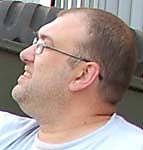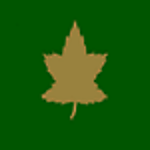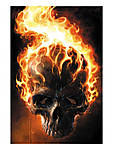Panthoholics,
Well, again itís been almost a month since I last posted an update and I didnít get a change to return during the same week that I posted to leave comments on the ongoing builds, that I previously mentioned I would be doing, my apologies to all. This makes my seventh installment on building this Panther F and the second part on working with PE parts. This update covers the PE fenders a little soldering and a few odds and ends.
There are several ways of joining PE parts together, that I am aware of, some of these methods being the use of liquid Cyanoacrylate glues that come in varying thickness each with its own setting time, this can be anywhere from 1-3 seconds up to 30 seconds. The Ethyl Cyanoacrylate Gel with a more prolonged setting time allowing the modeler some leeway to move and adjust the parts being joined. An acrylic hobby glue such as ĎGatorís Gripí mostly indented to be used for joining parts where there wonít be any stress on the joined parts and finally we have the strongest method of joining PE parts, that being solder. If you donít have any experience in soldering PE parts together donít let that stop you. It is easy!
As with any construction of parts youíll need to learn the methods and acquire tools for getting the job done. There are many methods for doing a job and just as many tools, with practice youíll develop your own methods and the tools donít have to be expensive or specialized. Iím going to cover the methods and tools I use for working with PE during this build and do my best to show you the how-to with these step-by-step (SBS) photograph and text intense updates. These first two updates are intended to give you a good idea of what you can do using PE parts to upgrade your kits using a few simple methods and materials and the proceeding updates will give you a more detailed in depth look at the tools, methods and process that I use to achieve good results every time. Just keep in mind that this is supposed to be fun and relaxing and that no model will ever be perfect, you only have to enjoy and be satisfied with your results. As with anything practice will make you a better modeler.
Nothing is better explained than seeing it done, monkey see, monkey do. Last October, there was a DVD being featured here on Armorama on working with PE parts and I went and bought that DVD, I personally donít have any affiliation with this product other than I think Adam Wilders work is some of the finest and most eye-catching that Iíve seen, I canít recommend this DVD enough, itís like having the dude at your home showing you how to work with PE. Well, if you donít already know about this DVD or havenít read the review entitled
Dealing with Photoetch by Jim Rae aka Ďjimbraeí, just click on the link and check it out and read through the comments. Hisham Haikal aka ĎHishamí comment best describes this DVD video:
Quoted Text
I just got mine this morning and I watched a good part of it... and all I can say is that if you're like me.. and have very little experience with PE and absolutely no experience with soldering.. then I strongly recommend this DVD for you.... Extremely nice, clear picture.. very clear explanation.. and of course, like I said before, seeing it done with such clarity makes all the difference.
Hisham
I wanted to post a link on working with PE but Iím going to save that one for latter in the build as it mostly deals with tool clamps. Anyhow lets move on to the PE fenders to keep some of that mud off the upper hull on that Panther.

A small Voyager Model (VM) photo-etch (PE) chain was added to the ball mount plug (D10) covering the St.G.44 replacement cast armor guard opening and the other end of the chain was secured to a PE tab located on the edge of the upper deck over the Radio Operatorís station. I soldered, filed, sanded (medium grit sanding stick) and polished (#0000 steel wool) the two-piece PE sun shield for the driverís periscope and fixed it to a PE brace (not shown in the photograph) that was fitted over the top of the driverís periscope guard (C13). This example of the sun shield for the driverís periscope is a vendor variation, it being shorter in both length and height in comparison to the more commonly seen sun shield (C36 - inset photograph). I then added the four VM PE crew compartment hatch bump stops per the Jentz & Doyle (J&D) scale prints.

After bending all of the VM left and right PE track guard sections they were now ready for being joined together. On the real vehicle these track guard sections were welded together for added strength. Here the left set of the PE track guards were placed on a flat wood block against a 6Ē (152.4 mm) long metal scale, bottom side facing up, and secured in place with Tamiya masking tape to keep them aligned to each other and from moving away from the metal scale while soldering all of the sections together. From this view you can see the bottle containing the liquid rosin flux and .015Ē (0.381 mm) diameter rosin core alloy solder strand that I used to solder the track guard sections together with.

After soldering the PE track guard sections together I checked them against the kit supplied track guards (C1 Ė Left & C47 Ė Right) as these matched the J&D scale prints. The VM PE track guards were longer in length than the kit track guards (green doted line) and there were four sections per side (red circles) for the PE track guards verses the six sections per side for the kit track guards (red arrows). The cut out for the shovel located on a left track guard section was also to short in length and narrow in width (red arrow).

Again the PE track guards were taped down to the wooden block, topside up, and except for the seam in the center sections of the track guards I solder filled each of the seams between the other sections.

The rosin flux thatís applied to the PE parts before soldering, used for cleaning and removing any oxidation from the surface and for aiding the solder to flow during the soldering process, is now removed with an Acetone soaked cotton tipped swab.

The PE track guards were then scribed to match the sections on the kit parts after which a small sized cone shaped burr, attached to a rotary tool, was used to replicate the weld joints between the track guard sections.

Here the PE track guards have been cut to length to match the kit parts and the cut out for the shovel has been reshaped to match the J&D scale prints. I also created button head bolt detail on the track guard sections in the appropriate locations according to the J&D scale prints by flipping the PE track guards bottom face up and using a worn rounded off metal scriber and small craft hammer.

Here all 12 of the PE brackets for mounting the Schuerzen plates have been bent to shape as well as the center and rear support plates for both the right and left PE track guards (circled in red). Indecently I used the Griffon Model PE center and rear support plates for the track guards, as the VM PE set did not include these pieces. The front track guard mounting brackets were also bent to shape. I know, I know I jumped ahead and finished off both front track guards without taking any photographs. Forming, soldering and dealing with the small hinges on these pieces while having to take care of some ĎHoney-Doís and my three-year-old Chihuahua, Tiger, whom had gotten sick, almost sent me out to the freeway at night! Ok, Ok my ĎBig Wheelí trick was broken so I never made it that far. Anyhow those two PE front track guards took me the better part of a day and night to complete. I just knew I should have grown a few more arms and hands when I was young! But, Noooo!

And again, I taped the PE track guards bottom face up against a 6Ē (152.4 mm) long metal scale on the wood block and soldered the mounting brackets for the Schuerzen plates to them. The metal scale was used to keep the mounting brackets from coming over the edge of the track guards. To set each of the mounting brackets into their proper location I first took a front / rear and middle Schuerzen plate and with a set of dividers I transferred the mounting cutout locations on the Schuerzen plates to the track guards and marked each location with a metal scriber. This gave me a visual reference to help me with the placement of the mounting brackets during the soldering process. Before soldering I checked the locations against the J&D scale prints. Theoretically I should be able to mount the Schuerzen plates onto the mounting brackets on the track guards without any problems. If you donít see the Schuerzen plates get mounted later in the build weíll all know I did something wrong? Got to get that ĎBig Wheelí fixed.

Now the completed track guards are placed on a paper towel and cleaned with an Acetone soaked acid brush. I donít use cotton tipped swabs here because of the many sharp edges and corners that the cotton could get caught on. I allow the Acetone to break down the rosin flux and repeat as necessary making sure Iíve remove all of the flux. The flux will not allow paint to adhere to the parts.

The two front track guard support brackets were then cemented into place on the chassis. On the real vehicle these brackets were welded directly to the forward section of the pannier panels located under the upper hull. I removed the plastic conduit from both the armor guard (D9) and headlamp base mount (K15) and drilled the penetration openings on both parts to accept a .020Ē (0.508 mm) diameter brass wire that I had cut and bent to shape to fit between them.

Here the front track guards have been attached to their respective brackets on the chassis and the side of each track guard fixed to the lower hulls side armor plates.

Prior to filling in the guide holes for the kit supplied track guards I had taken note of the distance between the upper edge of the superstructure (pannier) side armor plate and these guide holes for latter placement. Now using the noted dimensions and checking them against the J&D scale prints I drew a line along the surface of both superstructure side armor plates with a pencil for use as a guide in placing the track guards (red arrow). When I test fitted the track guards I found that the support braces leading away from the front track guards were to long in length and interfered with the forward mounting bracket for the Schuerzen plates so I had to cut them back (inset photograph).

The right and left track guards now fixed in place.

And from a wall by my workbench, a fat cockroaches view of the completed PE track guards fixed in place.

The last pieces to be fitted that completed the track guards were the angled support brackets for the two front track guards (circled in red on the bottom center inset photograph). I fabricated and stacked a flat and split washer from .005Ē thick styrene sheet using a punch and die set and placed an Armory nut & bolt on top of the stacked pieces which were then placed on top of the PE tab located on the edge of the upper deck (circled in red in the upper left inset photograph) per the J&D scale prints and what could be seen in the photographs on many of my reference books.

The tools and stuff I use for soldering PE parts. Not shown in the photograph is the solder wick used for wicking up excess solder, the medium grit sanding stick and #0000 steel wool I use for polishing out any oxidization and discoloration from the PE parts after soldering. Iíll try and remember to fit these items into photographs as I continue to post updates.
1) WES51 Weller soldering station, I got mine online at Amazon.com for $86.00 with shipping. My old $15.00 non-temperature adjusting soldering iron stopped working so it was time to get a real soldering iron!
2) Solder paste for refreshing the soldering tip of oxidization buildup allowing solder to adhere to the tip (always tin the solder tip with solder in between use and when not in use to help prevent oxidization).
3) Rosin solder flux. This is used for cleaning off any oxidization on the parts during the solder process, allows for good wetting and solder flow.
4) Water, for the sponge, prevents mineral buildup on the soldering iron tip and sponge Ė shows up as burnt BBQ on the solder tip (can be transferred to the soldered joint) and blackens the sponge from wiping the tip when cleaning off the old solder.
5) High and low temperature solders. Only the low temperature solder has a rosin flux core.
6) Butane gas micro torch, used for thick PE parts. Use of this will cause oxidization build up on the parts showing up as a dark discoloration with a dull appearance.
7) Tamiya masking tape, in various sizes.
8) Third hand fixture, because you didnít grow enough hands to hold several parts together at the same time while soldering.
9) Small vise for holding formed and bent parts that otherwise canít be taped down for soldering.
10) Flat end and cross action tweezers for holding parts together while soldering.
11) Heat sinks, used for placing between solder joints to keep the iron from re-liquefying an already made solder joint.
12) Wooden block, scale, pins and oilier.
13) Acetone, swabs and acid brush for cleaning flux residue from the solder joint after soldering.
As I still have the PE storage bins to build next I will do my best to present an in depth step-by-step (SBS) bending, soldering and attachment to the kit on my next update. I had thought about doing that this time but just couldnít get the time to shoot the photographs and build the kit at the same time, way to many things were happening here but everything seems to have settled down and now I have more time on my hands to get this project happening and even fix my 'Big Wheel'
Thanks for stopping by,
~ Eddy

There is one(O.K. two) things missing.J.T.
 Pics of that fix tomorrow.J.T.
Pics of that fix tomorrow.J.T.
































































